Contributory members are able to log private notes and comments about each site
Sites Anne T has logged. View this log as a table or view the most recent logs from everyone
Battle Stone (Kirknewton)
Trip No.41 Entry No.2 Date Added: 27th Aug 2017
Site Type: Standing Stone (Menhir)
Country: England (Northumberland)
Visited: Yes on 26th Aug 2017. My rating: Condition 3 Ambience 4 Access 4

Battle Stone (Kirknewton) submitted by Postman on 14th Jun 2017. With Yeavering bell as backdrop, one day I'll get up there too.
(View photo, vote or add a comment)
Log Text: Battle Stone, Kirknewton: This was our second unscheduled stop of the day, and one I was very pleased to have made.
Having turned off the A697 onto the B6351, just before the site of Ad Gefrin to the west, I spotted this stone on the OS map. Goodness knows how I’d missed it before, but then it’s a tiny little dot right on the edge of two maps we were using (OL16 and 339).
The stone is in a large field just under the shadow of Yeavering Bell, which glowed purple with the heather. There is a largish entrance to the field, hard-cored over, but the field was covered in ripening wheat. We could see the stone from afar and managed to follow the tractor path to about 8 metres away.
The stone had very different shapes, depending on what angle we viewed it at. Looking at the Historic England notes when we got back home, discovered that there are the remains of Old Yeavering Henge, which is preserved as a cropmark and lies 150m to the WNW, so it would be interesting to go back next spring, when the crop has been harvested and the field might be under grass.
We continued along the B6351 towards Kilham and Ring Chesters.
Ring Chesters
Trip No.41 Entry No.5 Date Added: 27th Aug 2017
Site Type: Hillfort
Country: England (Northumberland)
Visited: Yes on 26th Aug 2017. My rating: Condition 3 Ambience 5 Access 3

Ring Chesters submitted by Creative Commons on 21st Dec 2011. Ring Chesters hillfort. Copyright Andrew Curtis (http://www.geograph.org.uk/profile/32242), re-used under Creative Commons licence.
(View photo, vote or add a comment)
Log Text: Ring Chesters, Elsdonburn Shank: This was a relatively long walk. Having parked at Thompsons Wall Farm (NT 86817 30529), we took the tarmacked footpath up to Elsdonburn Shank farm (discussed farmhouse but the land is still farmed) and neatly kept.
Just before the barn at Elsdonburn Shank, we diverted down the footpath to (an un-named burn) where there is a gate leading to the small stream with stones placed to step across. From here, it is uphill towards the north and south ‘villages’, with large boulders punctuating the path. Having left the villages, there is a reasonably steep climb 160 metres or so up to the start of Ring Chesters Hillfort.
The black clouds had been gathering all afternoon, and as soon as my foot touched the second ring of the hillfort, the wind began to howl and raindrops stung my face. A lot of my photographs have rain splatter across them, despite constantly wiping the lens. Although the wind was strong and it was raining, it was still warm and I was in my sleeveless blouse.
The views around this hillfort are impressive, with 360 degree views. You can see as far as the sea to the north east. I clambered up the norther rings, where a trackway through has been worn by the sheep. From the aerial photographs, the main route is in the north west, with another in the south east - although this was less obvious as it was staggered, and the wind was much stronger in this direction and I felt I was being blown back to the west!
A quad bike track has been worn in the south western section, and this leads onto a level platform which looks as if it might be for either crops or animals.
The top is covered in structures and archaeology, which in the wind and rain was impossible to appreciate fully. Several roundhouses were visible, one in particular which seemed to have a hearth.
As we walked back down the hill towards the ‘villages’ the rain and wind stopped. I confess it was a relief to get out of the wind. This time we followed the marked footpath, which is towards the fence which runs just to the north of the northern-most village enclosure, and followed this until it disappeared. We then picked up the line of stones running towards the burn, up and over it, and back up the hill towards Elsdonburn Shank farm.
From here, we went in search of the elusive shielings that we’d missing on the way up. Passing by the barn near the farmhouse, I somehow managed to disturb all the pigeons roosting, and they came flying out of the barn like bats emerging from the eaves of a house in the evening.
Longknowe (Kilham)
Trip No.41 Entry No.3 Date Added: 28th Aug 2017
Site Type: Ancient Village or Settlement
Country: England (Northumberland)
Visited: Yes on 26th Aug 2017. My rating: Condition 2 Ambience 3 Access 5
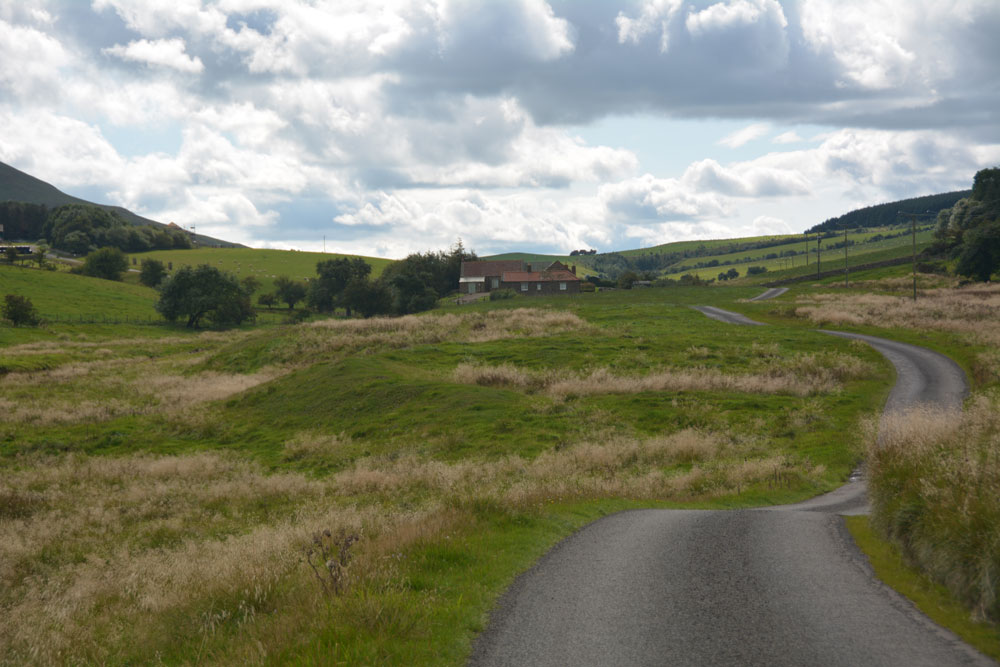
Longknowe (Kilham) submitted by Anne T on 28th Aug 2017. First view of the Longknowe settlement, approaching it from the minor road from Kilham to Longknowe and Thompsons Walls farms.
(View photo, vote or add a comment)
Log Text: Longknowe Settlement, Kilham: Our first scheduled stop of the day, having been diverted by two very interesting standing stones!
Driving down the single track road towards Longknowe Farm and Thompsons Walls, it was a bit tricky to track precisely where we were on the road because of all the little twists and turns it took. But when we first saw the settlement from a distance, cut by the road, it was obvious what it was.
This is a very pretty little valley, if somewhat remote, surrounded by tall hills to the south, east and west, with a pretty (unnamed burn/syke) running alongside the eastern side of the settlement, back towards Kilham. Another small stream, but with a fast water flow, trickled to the west. The farmer had cut a drainage channel with led this to the burn to the east of the settlement.
The stony banks of the settlement were an obvious brighter green and with shorter grass, than the tall yellow grass in the landscape surrounding it. The settlement has been clearly cut by the road. There is a large round hollow area in the northern part of the settlement, with a few stones peeking out of the grass - the remains of the 7m hut circle?
Described as ‘much robbed’ and in poor condition, if the farmer decides to put hay bales or any farming equipment here, then this will probably destroy what remains of this settlement.
Onwards and upwards to park the car at Thompsons Walls and walk up to Ring Chesters, with the dark clouds gathering above us.
Elsdonburn Shank (Kilham)
Trip No.41 Entry No.4 Date Added: 28th Aug 2017
Site Type: Ancient Village or Settlement
Country: England (Northumberland)
Visited: Yes on 26th Aug 2017. My rating: Condition 2 Ambience 4 Access 3
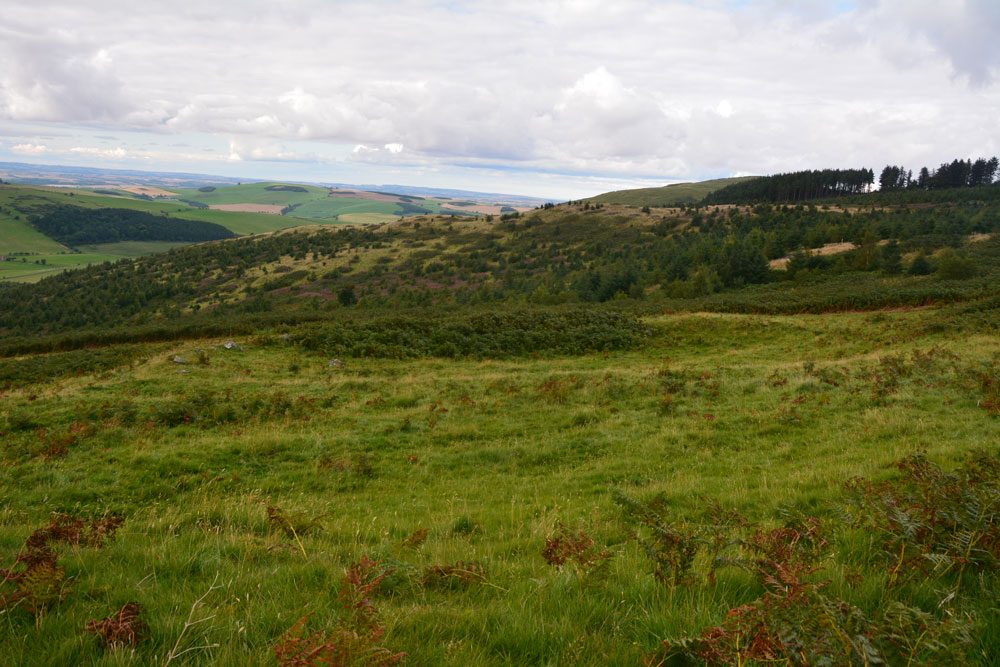
Elsdonburn Shank (Kilham) submitted by Anne T on 28th Aug 2017. Enclosure A from the northern-most part of the bank of Enclosure B.
(View photo, vote or add a comment)
Log Text: Elsdonburn Shank Villages, Kilham: Why are all the interesting sites up, up, up hill?? From Longknowe Settlement, we drove to Thompsons Walls and parked just behind their stack of sileage bales. The footpath continues here, and is metalled, but is a private road, so we decided not to drive any further.
It is a very pleasant walk along this road, with the hills looming around you on three sides. The ground looks very fertile here, and there were many, many sheep and their lambs on the green pasture. The farmer passed me with his large mower and gave a great wave. We later saw him mowing the grass in a meadow on the other side of the valley.
The footpath splits at the point where a burn tumbles down from a wood and goes underneath the road. We took the left hand fork which runs up to Elsdonburn Shank Farm, the house now deserted but the land and barn still used.
Just before the barn, the footpath dives off diagonally south east across the field, leading down to a gate just before the stream. It looks at first glance as if this stream is going to be wide, because the valley is quite deep, but when you get down to it, it’s just a little trickle, with a few stones placed across to make it easy to cross. From here, the footpath disappeared, and we ended up tracked north east up the hill, led by a string of large boulders which seemed (to us) to mark the track. In fact higher up, the footpath has been mown of bracken and leads along the fence line up the hill.
Just as I was getting tired of clambering up the slope, Village A came into view and we sat on the western side of the bank to have a drink before exploring. Well worth coming up here. Enclosure A was easier to decipher than B, which had much more bracken growing within it, and a tumble of stones peeking out of the grass.
With the dark skies getting darker, we plodded up the hill towards Ring Chesters.
Elsdonburn Shank Shielings (Kilham)
Trip No.41 Entry No.6 Date Added: 28th Aug 2017
Site Type: Ancient Village or Settlement
Country: England (Northumberland)
Visited: Yes on 26th Aug 2017. My rating: Condition 1 Ambience 3 Access 3
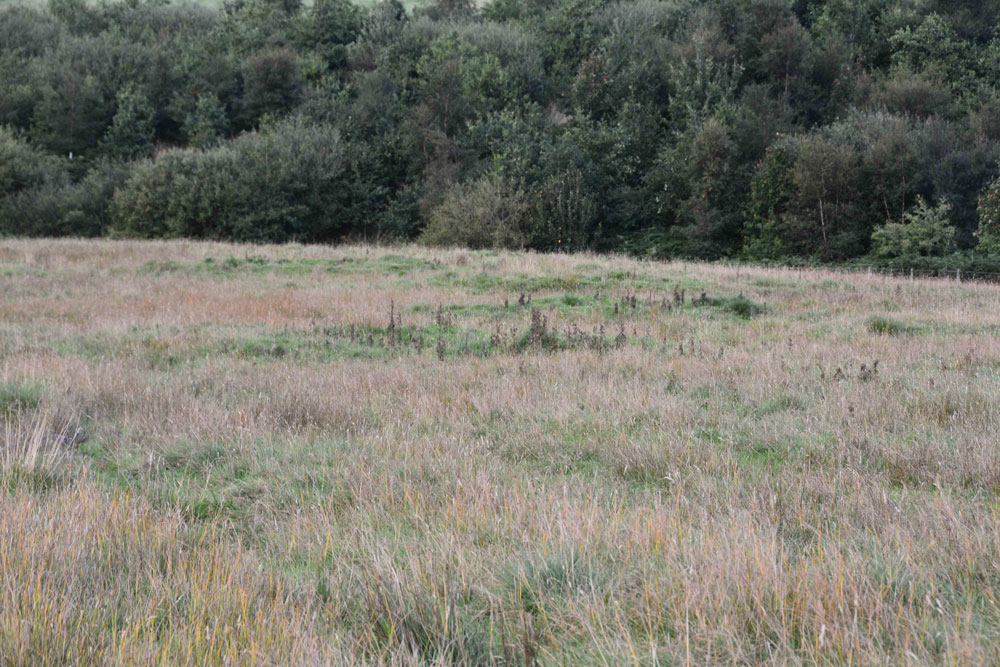
Elsdonburn Shank Shielings (Kilham) submitted by Anne T on 28th Aug 2017. Having walked by these shielings on the way up the hill, they were actually far more visible coming down the track from Elsdonburn Shank farm. The turf covered foundations, like Longknowe Settlement nearby, stood out as a darker green with lower growing grass, as opposed to the yellowing stems of taller grass around them.
(View photo, vote or add a comment)
Log Text: Elsdonburn Shank Shielings, Kilham: Husband had read somewhere that these might possibly have Saxon origins, although I’ve not been able to find the link.
Marked on the OS map as ‘old shielings’ we missed these on the walk up to Elsdonburn Shank as I was looking on the wrong side of the track. Actually, they were more visible on the way down, in the early evening light, with the very slight banks of the shielings a darker green and with lower growing grass on their surface. If I hadn’t been out with the archaeology group surveying shieldings, I would have passed these by.
We spent about 10 minutes here wandering around, trying to work out the shape of the structures. Not a huge amount so see, but another Pastscape site in the vicinity of Ring Chesters marked off.
St. Gregory's The Great (Kirknewton)
Trip No.41 Entry No.7 Date Added: 28th Aug 2017
Site Type: Sculptured Stone
Country: England (Northumberland)
Visited: Yes on 26th Aug 2017. My rating: Condition 3 Ambience 4 Access 5
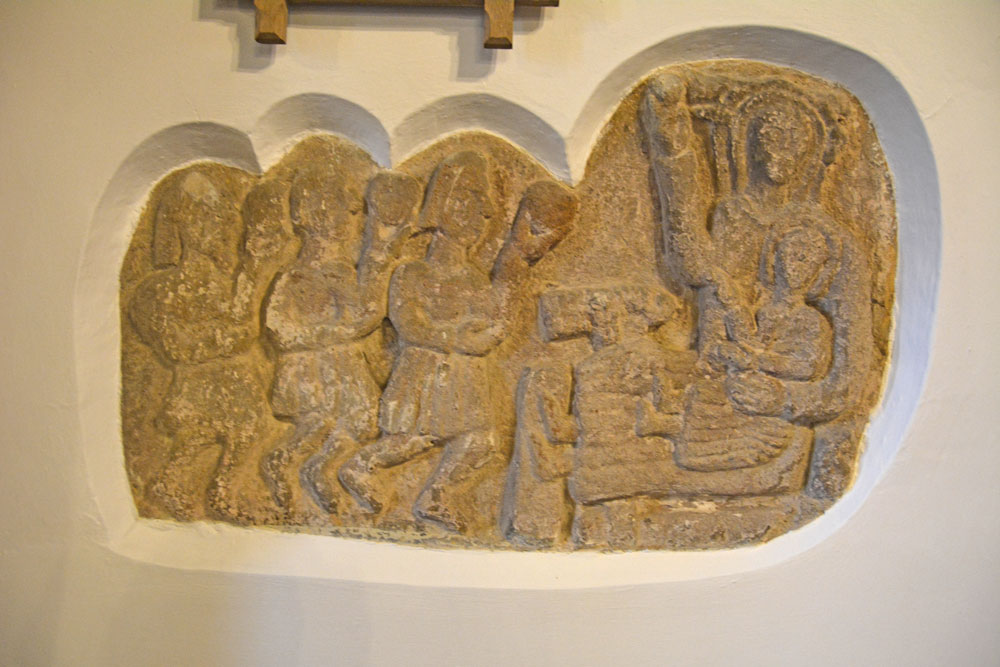
St. Gregory's The Great (Kirknewton) submitted by Anne T on 28th Aug 2017. The unusual Adoration of the Magi, with the Magi in what looks like kilts, but which are probably Roman tunics. Historic England says this dates from the 12th century, but the church thinks it might be several centuries earlier, pre-dating the church.
(View photo, vote or add a comment)
Log Text: The Adoration of the Magi (in Roman tunics): St. Gregory's The Great, Kirknewton: I confess to not being ready to go back home as it was such a nice evening, and this church looked very welcoming, so we stopped off for a look.
The main entrance to the church yard leads over a small, nicely landscaped stream. Immediately facing you to the left hand side of the path are some Commonwealth War Graves, very nicely tended, and all of air force pilots from 1943, mostly in their early 20s; one man was from Brazil. Inside the church there is a lovely sculpture and stained glass dedicated to these men.
There was no church guide to take away, but there were notices all over the church with explanations. There was a stone carving -The Adoration of the Magi, sited in the wall to the north side of the chancel.. The interpretation board near it reads: “The carving is quite amazing as it appear to show the Magi in kilts (but probably Roman tunics). The ancient stone relief is a great treasure of the church, being at least 12th century and could be earlier. There is some evidence to suggest that the style of the Magi “caps” is similar to an example in the Roman catacombs, so there could be the influence of St. Paulinus, himself a Roman (who supposedly preached at Kirknewton) and would date the carving at several centuries earlier, pre-dating the church (where was it prior to that?).”
The chancel and sanctuary look as if they have been fortified and used for defensive purposes (barrel vaulted ceiling and thick walls). I enjoyed walking round this church. It had a very friendly feel and was very well looked after.
Hunstanworth Moor south
Trip No.42 Entry No.3 Date Added: 29th Aug 2017
Site Type: Standing Stone (Menhir)
Country: England (County Durham)
Visited: Yes on 28th Aug 2017. My rating: Condition 3 Ambience 3 Access 5
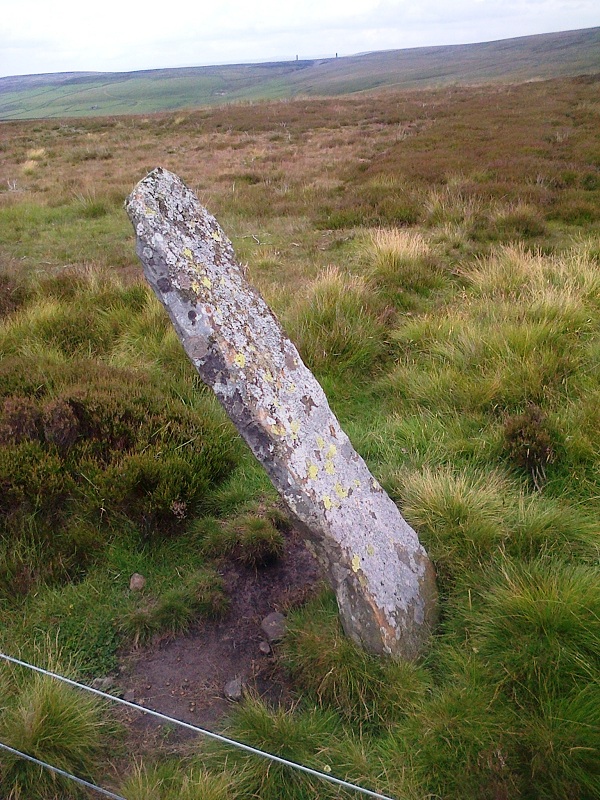
Hunstanworth Moor south submitted by HarperFox on 20th Jul 2014. This is the southernmost of the two roadside stones on the road between Townfield and Rookhope. The other is similar in shape and dimensions but upright.
(View photo, vote or add a comment)
Log Text: Hunstanworth Moor South, Near Townhead: This stone is marked on the OS Map as ‘stone’, and was easily found, although it seems like a tall boundary marker along the road from Townhead to Rookhope. As we drove along the road, we passed the northern boundary stone (see below), which isn’t marked on the map and was unexpected.
Haven’t been able to find out anything about these – not even a photograph on Geograph, as Andy Curtis has usually been out and about photographing all these places before us.
We backtracked to photograph the northern boundary stone on our way back to see the remains of the Edmundbyers Cross. I was impressed by all the now disused lead mining buildings and spoil heaps around here. It must have really busy in the not so distant past.
Hunstanworth Moor north
Trip No.42 Entry No.4 Date Added: 29th Aug 2017
Site Type: Standing Stone (Menhir)
Country: England (County Durham)
Visited: Yes on 28th Aug 2017. My rating: Condition 3 Ambience 3 Access 5

Hunstanworth Moor north submitted by HarperFox on 20th Jul 2014. This is the northernmost of the two stones.
(View photo, vote or add a comment)
Log Text: Hunstanworth Moor North, Townhead: Being the day of the Blanchland and Hunstanworth Show, this road was very busy, and it was difficult to stop as the road was narrow and there were no obvious lay-bys or pull-off points (there being a nice ditch at the western side of the road and a steep bank up to the field on the east).
Spotted this stone as we were passing by on the way to the stone approx. 575m south and retraced our steps to photograph it.
Again, after having done searches on the internet, not been able to find out anything about it, like it’s ‘partner’ further up the hill.
Feldon Plain (Muggleswick)
Trip No.42 Entry No.5 Date Added: 29th Aug 2017
Site Type: Marker Stone
Country: England (Northumberland)
Visited: Yes on 28th Aug 2017. My rating: Condition 3 Ambience 3 Access 5

Feldon Plain (Muggleswick) submitted by Anne T on 29th Aug 2017. The stone (and sheep) as seen from the north east. There is a level mark almost at ground level, on the side facing the road. It certainly is in a lonely spot. It sits precisely on the parish boundary between Muggleswick and Hunstanwick (if I've read the map correctly) and also almost at the junction of two major routes across the moors.
(View photo, vote or add a comment)
Log Text: Marker Stone, junction of Meadows Edge & B6278: Despite quite an intensive search, I’ve not found any information on the internet (checked Pastscape, Historic England, National Geograph, etc).
Marked ‘BS’ on the OS map, this impressively large stone (in comparison to the others we saw on the way here) sits exactly on the Parish boundary between Muggleswick and Hunstanwick (if I’ve read the map correctly). Sitting right by the side of the B62787 to Edmundbyers, close to its junction with the Meadows Edge Road.
This is close to the remains of the Edmundbyers Cross Base, just to the north east, with Feldon Plain rising up gently behind it. It is a taller version of Hunstanworth North, again with the sloping top. It sits in a slight dip, as if the ground surface has built up around it, and there are a few packing stones visible at its base. Looks as if it has been here for a while.
Its shape echoes that of Hunstanworth Moor North, being long, thin & narrow with a sloping top.
Edmundbyers Cross (Muggleswick)
Trip No.42 Entry No.6 Date Added: 29th Aug 2017
Site Type: Ancient Cross
Country: England (Northumberland)
Visited: Yes on 28th Aug 2017. My rating: Condition 2 Ambience 3 Access 5
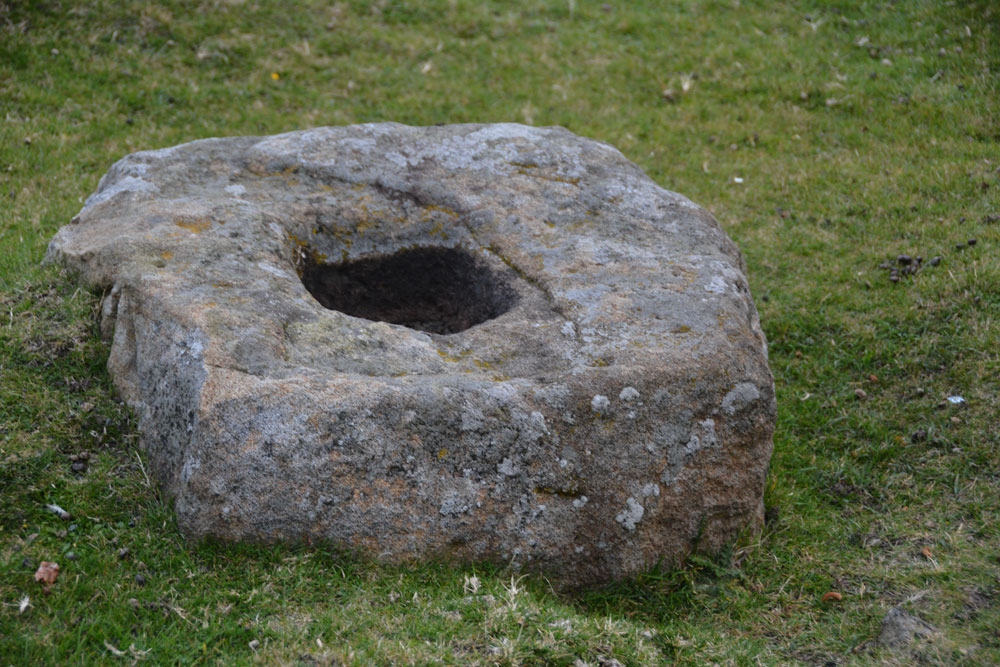
Edmundbyers Cross (Muggleswick) submitted by Anne T on 29th Aug 2017. Close up of the cross base, showing its socket hole.
(View photo, vote or add a comment)
Log Text: Remains of Edmundbyers Cross, Muggleswick: Marked in italic, old fashioned script on the OS map, I guess I was expecting something a little more exciting, such as a cross base with part of a shaft, but no. Just a cross base. Good job I knew what I was looking for as alongside the road there were other pieces of rectangular rock almost as large.
Sitting almost at the junction of the B6278 to Edmundbyers with the minor road leading almost to Smiddy Shaw Reservoir (just to the north of this road), it would have acted as a way marker. The cross base is located just over 1km from the boundary stone above.
When we got home, I was interested to read this from the Historic England entry: “Edmundbyers Cross is one of only three wayside crosses still in its original position in County Durham and the only known example on the route between Stanhope and Edmundbyers.”
Old Man's Grave (Edmunbyers)
Trip No.42 Entry No.1 Date Added: 30th Aug 2017
Site Type: Marker Stone
Country: England (County Durham)
Visited: Yes on 28th Aug 2017. My rating: Condition 3 Ambience 2 Access 4

Old Man's Grave (Edmunbyers) submitted by Anne T on 30th Aug 2017. First view of the stone, which sits between two footpaths on the parish boundary between Edmundbyers and Hunstanworth. Marked on the OS map, I wondered if the installation of the corner fence post had disturbed its location.
(View photo, vote or add a comment)
Log Text: Old Man's Grave, Meadows Edge Road, Near Blanchland: We originally intended to go to Blanchland to look at a holy well marked on the OS map, not far from the town square, but the village show was on and it was impossible to park. We drove on across to the moors, intended to stop at a boundary stone on the way to Old Man’s grave, but the roads were too busy to stop.
I was expecting a cairn, but this is a small, relatively modern boundary marker, sited between two footpaths, and at the corner of a modern fence.
Not impressed, but stopped to photograph it anyway. Certainly stunning views, and I’m guessing at some time in the past this might have been a cairn with a way marker on top, or by, especially with it being located just up the hill from where Bale Hill turns into Meadows Edge, and where two different trackways led off the north east and south west off Meadows Edge across the moorland.
Dead Friar's Stone (Stanhope)
Trip No.42 Entry No.2 Date Added: 31st Aug 2017
Site Type: Marker Stone
Country: England (County Durham)
Visited: Yes on 28th Aug 2017. My rating: Condition 3 Ambience 3 Access 5
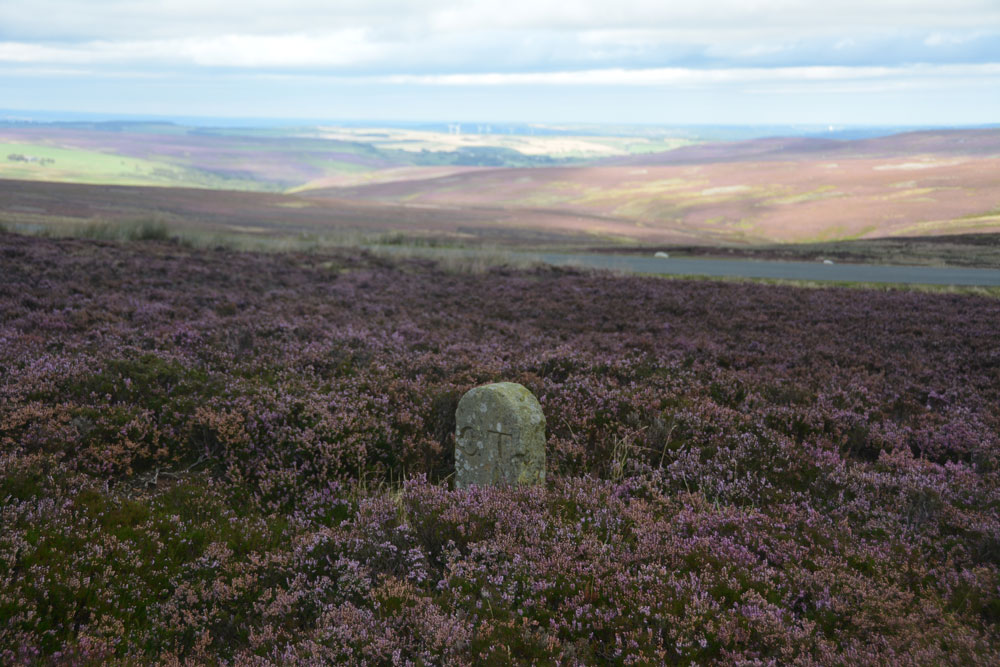
Dead Friar's Stone (Stanhope) submitted by Anne T on 31st Aug 2017. Standing at the edge of the parking area looking north east towards Edmundbyers.
(View photo, vote or add a comment)
Log Text: Dead Friar's Stone, Stanhope: From Old Man's Grave, just north of this stone, this was our second stop of the day - a curiously named stone next to Dead Friar’s quarry. Amusingly, husband thought a great slab of concrete lying next to the car park was the stone lying on its side! We looked again.
At a great viewpoint eastwards, although I thought this perhaps should have been a taller way marker rather than a boundary stone, given where it stands – at a bend of Meadows Edge (marked Dead Friar’s Road on the OS map), and where another smaller track heads off across the moorland westwards, then south, towards Rookhope.
The area around Rookhope always has ‘not very nice’ connotations for me, given my son-in-laws brother was killed in an accident green-laning on his trials bike just over 2 years ago, and I was glad to move on from this lonely spot.
Housesteads Tumulus
Trip No.43 Entry No.3 Date Added: 4th Sep 2017
Site Type: Artificial Mound
Country: England (Northumberland)
Visited: Yes on 2nd Sep 2017. My rating: Condition 2 Ambience 2 Access 5
Housesteads Tumulus submitted by SolarMegalith on 21st Jul 2016. The mound seen from the S-SE (photo taken on July 2016).
(View photo, vote or add a comment)
Log Text: Housesteads Tumulus, Northumberland: From photographing the remains of Triermain Castle and after having failed to see several sites today because of Boisterous Bullocks or lack of parking reasonably near the well, I wasn’t in the frame of mind to go straight home. As we were very near the B6318, I asked to go back that way to see ‘Solarmegaliths Mound’ opposite Housesteads. I hadn’t realised until I looked closely that this is marked on the OS Map.
By this time it was 7pm and the car park was empty apart from one car and a very large campervan. I confess that every time we’ve driven past this site, I thought how unsightly this ‘farmer’s dump’ was in the corner of the field. It was only when Cezary told me on one of the archaeological field days that he’d stopped off to see this site, that I promised myself one day I’d stop off and look for myself.
As a mound, it is a little non-descript, but having crossed the road from Housesteads car park, we let ourselves into the field (knot untying skills came in useful again) and walked round. The whole area around the base of the tumulus has been used as a dump and there is rubbish and fence posts around much of it.
Also marked on the OS map is a mound, further south and we walked further into the field (ducking from the farmer's trucks with trailers behind them, in case we got caught!).
Having walked back to the car park, we noticed a sign saying there had been an application made for number plate recognition for car park charging. We looked around for cameras, but couldn’t see any. If a parking charge notice comes through the door in the next few weeks, I will be cross.
Housesteads Mound
Trip No.43 Entry No.4 Date Added: 4th Sep 2017
Site Type: Misc. Earthwork
Country: England (Northumberland)
Visited: Yes on 2nd Sep 2017. My rating: Condition 2 Ambience 3 Access 4

Housesteads Mound submitted by Anne T on 4th Sep 2017. We didn't walk down to the mound, as we didn't have permission to be in the field, but it looks like a small tumulus to my untrained eye. There are no other features like this along this section of land running alongside the B6318 Military Road, at least within about half a kilometre either side, apart from another tumulus on Green Brae, near East Crindledykes.
(View photo, vote or add a comment)
Log Text: Housesteads Mound, near Housesteads Tumulus, Bardon Mill: This mound is marked on the OS map as a mound, and as we were in the field, walked to the change in slope where the ground dipped into a hollow. The mound was certainly popular with the sheep. Didn’t walk down to it, as it was a fair way across the field and it was getting late. I’d called it up on my mobile phone, and it didn’t seem hugely important.
Coanwood (Lambley)
Trip No.43 Entry No.1 Date Added: 5th Sep 2017
Site Type: Ancient Village or Settlement
Country: England (Northumberland)
Visited: Yes on 2nd Sep 2017. My rating: Condition 3 Ambience 3 Access 5

Coanwood (Lambley) submitted by Anne T on 5th Sep 2017. The eastern bank of the enclosure as it runs south along the fence line inside the field.
(View photo, vote or add a comment)
Log Text: Coanwood Settlement, Lambley: Driving from the Diamond Oak and the World War II prisoner of war camp to the north, this settlement lies immediately opposite the junction of the 68 Cycle Route and the A689 at Lambley. It lies very near the Roman route of Maiden Way, which in this part of the world goes over Hartleyburn Fell and Glendue Fell, and runs west of this settlement, following the route of the Pennine Way through Lambley Common.
We decided, on impulse, to stop and have a look, especially as there was a handy hard-cored parking space next to the green pumping station and were so interested, I did something I don’t usually do, and let myself into the field to walk along the track running parallel with the southern bank.
I could make out a rectangular structure in the south eastern corner, and possible hut circle mid-way across and one-third of the length south of the northern bank.
Haining House (Lambley)
Trip No.43 Entry No.2 Date Added: 5th Sep 2017
Site Type: Cairn
Country: England (Northumberland)
Visited: Yes on 2nd Sep 2017. My rating: Condition 3 Ambience 4 Access 4
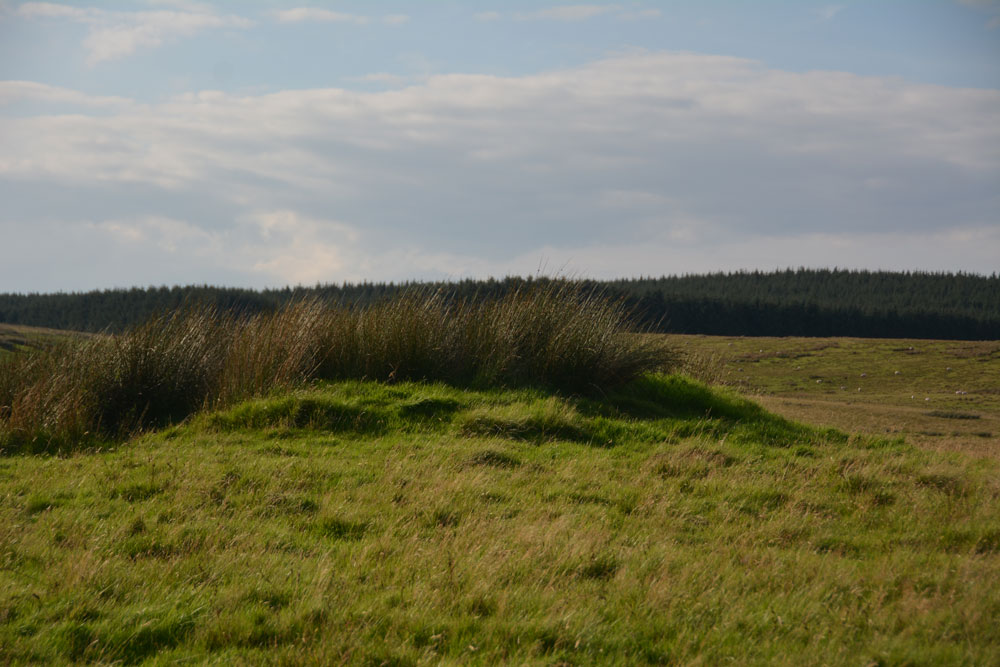
Haining House (Lambley) submitted by Anne T on 5th Sep 2017. First view of the cairn, peeking northwards over the stone wall which runs parallel with the track leading up to Haining House on Hartleyburn Common.
(View photo, vote or add a comment)
Log Text: Haining House Cairn, Hartleyburn Common: It was difficult to park here, as the road was so narrow. In the end we managed to bump the car up a slight bank to the north east of the track to Haining House. The track to the farm house was well looked after, although to drive to it, you’d have had to opened (and shut) three gates.
The cairn was easily identify-able, and being on access land, we walked to the gate located in the stone wall just to the west of the cairn, and walked back. There are some curiously deeply cut valleys to the north west of this cairn, now in a u-shaped feature. There are some cup and ring marked rocks along this section of the burn, although we planned to walk further west to see some more settlements this afternoon.
However, leaving the cairn and letting ourselves into a field with a gate, the heads of some very curious, and large, cattle/bullocks appeared above a slight mound. We retreated and went to look at the map for some other sites to see.
Christening Stone (Cotherstone)
Trip No.44 Entry No.1 Date Added: 15th Sep 2017
Site Type: Ancient Cross
Country: England (County Durham)
Visited: Yes on 9th Sep 2017. My rating: Condition 3 Ambience 3 Access 5
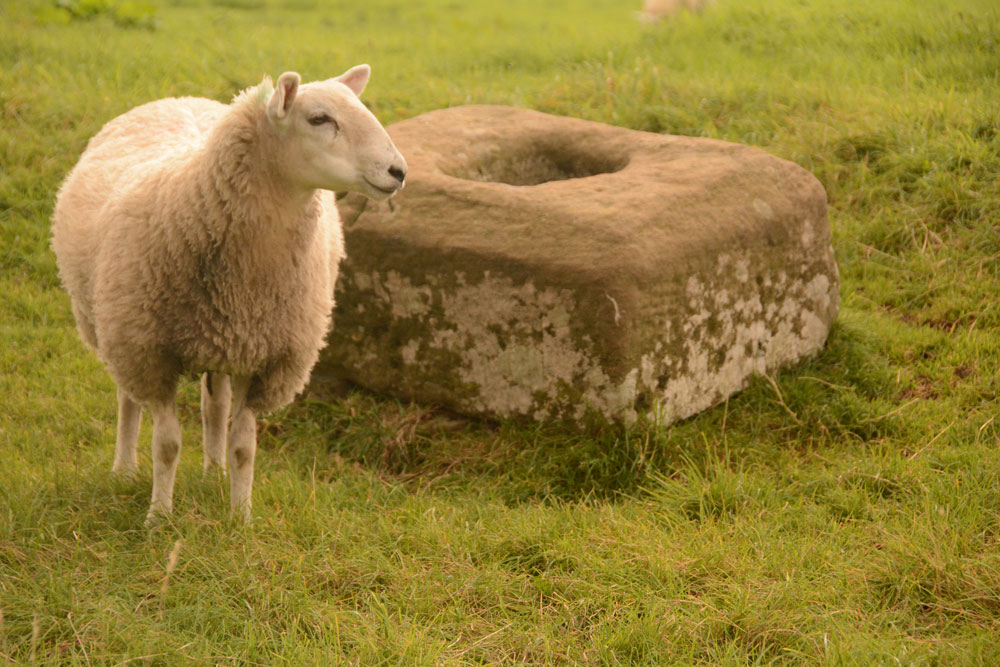
Christening Stone (Cotherstone) submitted by Anne T on 10th Sep 2017. First view of The Christening Stone from over the stone wall alongside Spout Bank (B6277), 160 metres south east of Doe Park Caravan Park.
(View photo, vote or add a comment)
Log Text: The Christening Stone, Cotherstone: This was our first stop of the day. Travelling south on the A68, the shortest route was cross-country through Hamsterley, driving along the B6278 Folly Bank into Eggleston, then turning onto the B6277 through Romaldkirk. The cross base is in a field to the right hand side of the road, 160 metres south of Doe Park caravan park, on Spout Bank.
The road is busy and narrow, but we managed to pull off into a double gateway at the side of the road and cross over to peer at the cross base. A sheep was huddled up to it when I first saw the base. The sheep then stood up once it noticed me and stood by the cross base, as if it was showing it off.
The cross looks as if it was sitting by the side of a hollow way, although now on a slope where the land dips towards the road. It looks quite crisply carved still. Although there was no gateway into the field, the stone wall was really low in places, and Andrew hopped over the wall to take a quick photograph of the western side of the base.
Pastscape says the base is Grade II listed and is in its original position on the medieval route between Cotherstone and Romaldkirk. Called The Christening Stone, a calf was christened at this cross as part of the May Day celebrations.
The Butter Stone
Trip No.44 Entry No.2 Date Added: 10th Sep 2017
Site Type: Standing Stone (Menhir)
Country: England (County Durham)
Visited: Yes on 9th Sep 2017. My rating: Condition 3 Ambience 3 Access 4
The Butter Stone submitted by durhamnature on 16th Jul 2012. The Butter Stone, the hills of Teesdale in the background.
Site in County Durham England
(View photo, vote or add a comment)
Log Text: The Butter Stone, Cotherstone: From the cross base, we continued along the B6277, turning onto the minor road from Cotherstone towards the Battle Hill Ranges. We hadn’t expected to turn from pasture and woodland almost straight onto a moorland road.
From the turning in Cotherstone to the Butter Stone is almost 1.7km. Just passing a farm entrance to the east of the road, the stone is almost immediately to the west, about 25 metres from the side of the road. A narrow grassy footpath leads from the road to the stone, which appears to be a well eroded natural erratic. It just about shows above the tussocky grass around it.
A old penny had been glued into a hollow in the top of the stone, and in the other hollows around the outside of the stone there were 20 pence pieces slotted into them.
I was surprised to find this stone was used as an exchange/boundary point during the 17th century plague, and it is sited just below the brow of the hill.
St Mary's Old Church (Brignall)
Trip No.44 Entry No.4 Date Added: 15th Sep 2017
Site Type: Ancient Cross
Country: England (County Durham)
Visited: Yes on 9th Sep 2017. My rating: Condition 2 Ambience 4 Access 4
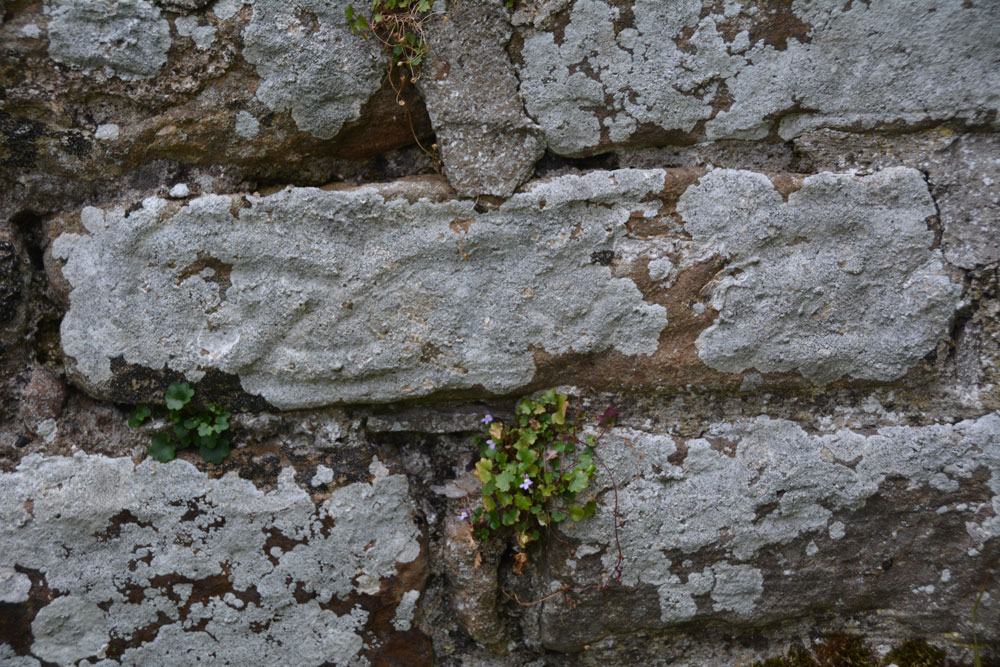
St Mary's Old Church (Brignall) submitted by Anne T on 11th Sep 2017. The interlacing can be seen on this piece of 9th century cross shaft, built into the north wall on the west side of the opening in the wall.
(View photo, vote or add a comment)
Log Text: 9th century cross shaft, St. Mary's Old Church, Brignall: Deserted Medieval Village: After not being able to find the cross base in ‘New St. Mary’s Church’, we left the car parked in front of the church and took the footpath to ‘The Old Church’ between the south wall of the churchyard and the neighbouring house. This quickly took us down an overgrown lane, following a small stream in a deep gulley to our left hand side. As the crow flies, it’s only 500 metres from the ‘new church’ to the ‘old church’, although it felt a lot longer.
Where the trees started to clear, with fields to our right, the path turned back on itself, seeming to lead straight down the gully to our stream. There was no signpost to say where the old church was, so we took the path leading downwards (to our left), at one point walking between two streams, and came out into a meadow. In the distance was the ruins of a small buildings surrounded by a low stone wall. It looked more like a tumbled down small farm house, but as we got nearer, the grave stones appeared above the wall line.
The gate had been firmly locked with a bolt and nuts, so we used the stile over the wall, descending into brambles and nettles. Other people had obviously walked this way as there were traces of indistinct tracks leading in various directions across the churchyard.
Making our way over to the building, we couldn’t see the piece of cross shaft, so I called the image up on my phone, having to hold it high up above my head to get a better signal! Almost immediately, I spotted it – to the left hand side of the opening in the wall (north), a few layers up from the current ground level.
The Historic England entry also said that there were re-used cross slabs over the east window and the now re-filled smaller windows in the east wall. On closer inspection, these looked like re-used grave slabs.
It wasn’t until we left the grounds of the church and followed a line of boulders leading down to what we thought was a stream, that we found out the River Greta ran just to the east of the church. The rig and furrow ploughing across the field was really obvious and it may be the stones marked the line of a crossing through the river? The Historic England entry also says the site has been painted by Turner and others.
St. Mary's Church (Brignall)
Trip No.44 Entry No.3 Date Added: 15th Sep 2017
Site Type: Ancient Cross
Country: England (County Durham)
Visited: Yes on 9th Sep 2017. My rating: Condition 3 Ambience 2 Access 5
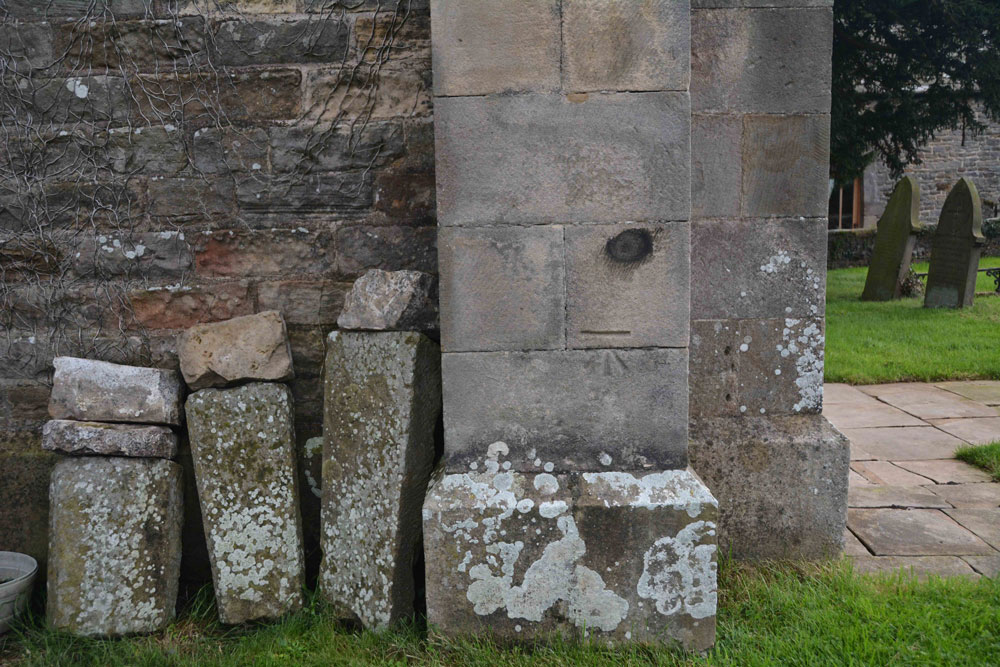
St. Mary's Church (Brignall) submitted by Anne T on 11th Sep 2017. The remains of a cross base, together with a Roman altar, are said to stand against the south wall of the church outside its west end.
This was the only collection of stones we could find on or near the church walls, and these sit against the north western corner of the tower.
(View photo, vote or add a comment)
Log Text: Cross base at St. Mary's New Church, Brignall (not found): After having visited the church in Barnard Castle and Barnard Castle, we set of to Brignall. According to Pastscape, there was a 13th century cross base sitting against the south-west corner of the tower of this church, together with a Roman altar and other stones. These used to be in the rectory gardens, but were re-sited in the churchyard.
No sign of the cross base or the altar existed, unless they are in this collection of stones, all of which are badly worn. These are located against the north west corner of the tower, behind the war memorial. There was nothing against the south west corner/south west wall of the church – I walked right round in case we’d missed anything, or they had been moved.
The church was locked at the time of our visit, so I couldn’t get inside to check if these artefacts had been moved inside for safety. As we parked up, a man in the house next to the church (to its right as photographed) was standing at the window looking at us, talking on the phone. He made no move to come out and talk to us, and made me feel like an intruder.
I will need to phone the Diocesan office to find out when the church is open and if the base and altar have been moved inside the church.
